10 Best Shrimps for Your Freshwater Aquarium
Tropical shrimps add color and variety to your tank. They come in different sizes and shapes and are fascinating to watch. The fun element that shrimps bring to your tank is not without cost. You have to carefully pick your varieties depending on your experience and the type of tank you have.
Some shrimp varieties require a high pH environment while some like the RCS varieties are more tolerant. Your journey to keeping freshwater shrimp successfully starts with picking the right varieties. Some common types of tropical freshwater shrimp that make great pets include;
Red Cherry Shrimp
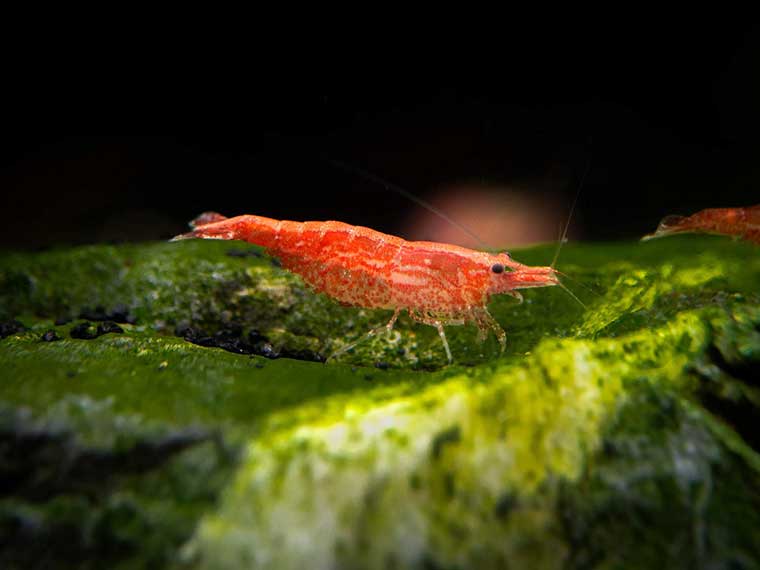
Red cherries are popular because of their beautiful and bright colors. They are also among the easy varieties to care for which makes them perfect for beginners.
Red cherry shrimps thrive in community tanks along passive freshwater fish varieties. Like most shrimp, they eat anything and are great tank cleaners.
Ghost Shrimp
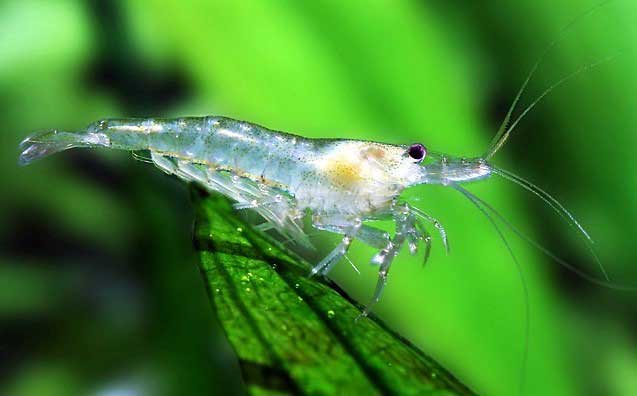
For first-time owners, ghost shrimp are highly recommended. They are the easiest type of freshwater shrimps to care for and are ferocious scavengers and they are also prey to larger tank mates.
Ghost shrimps have a short lifespan of just one year. For aquarists who build bonds with their pets, these might not be a good option. However, their short lifespan makes them more affordable.
Snowball Shrimp
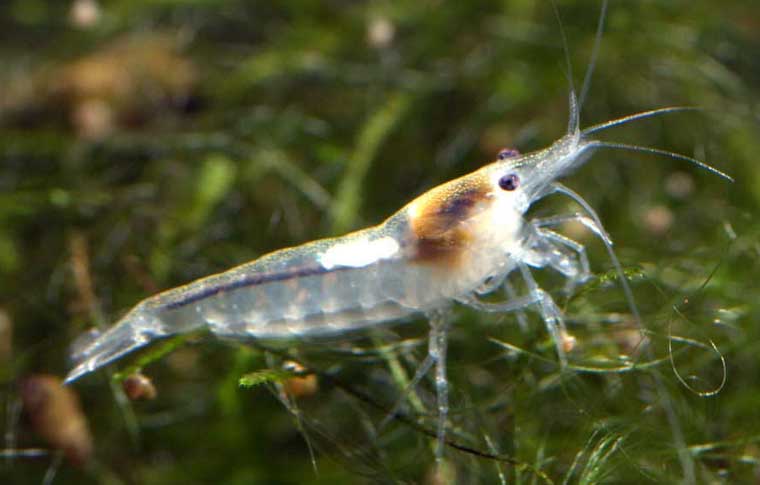
Also known as white pearl shrimp, the snowball variety stands out in the tank because of its pure white color. Its unique appearance enhances the look of your passive tropical community. This type of shrimp is easy to breed and keep making it perfect for beginners.
Other than the aesthetics, the snowball shrimp is a hard worker that feeds on detritus, algae and microorganisms in the tank. The shrimp will also feed on blanched greens like spinach and zucchini as well as algae wafers and flakes.
Blue Tiger Shrimp
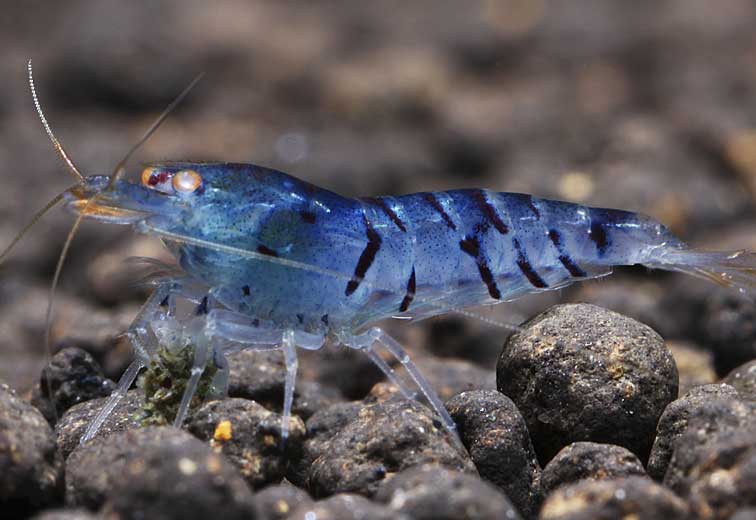
The blue tiger shrimp is a color variant of the Southeast Asian Tiger Shrimp. It has been bred over the years to accentuate the blue the color.
Blue tiger shrimps are hardy and do well in a shrimp only tank or in a peaceful community tank. Blue tigers spend most of their time grazing on the algae growing in the aquarium. This type of shrimp is not ideal for beginners largely because of its stringent water quality and pH requirements. It thrives in soft, acidic waters.
Panda Shrimp
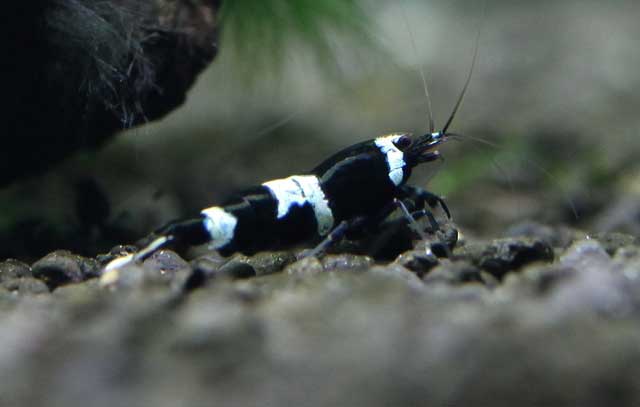
The panda shrimp gets its name from the black and white strips that cover its body. They aren’t the easiest species to keep and are very sensitive to water changes and breed slowly.
For the more experienced shrimp keepers, they are worth the effort. With proper care, they can thrive and become quite the sight in your tank.
Most aquarist prefer to keep panda shrimp in shrimp-only tanks to reduce the risk of losing the clutch to other tank mates. Pandas are also picky eaters but will generally munch on high grade vegetarian shrimp feed or blanched spinach.
Babaulti Shrimp
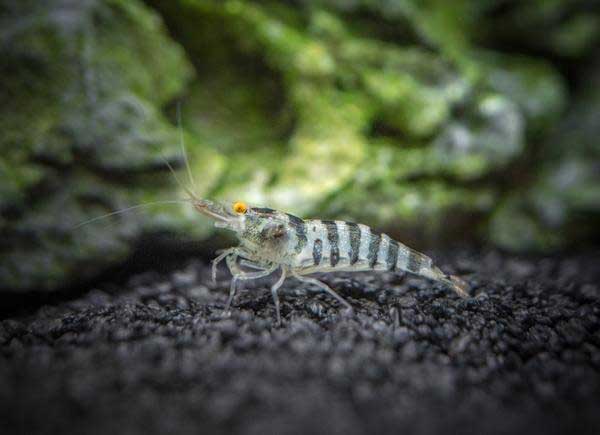
The Babaulti is a fan-favorite because of its vibrant colors. It can come in shades of red, brown, green or yellow and sometimes zebra stripes.
It’s a hardy shrimp species making it ideal for beginners, but they tend to be a little shy compared to other shrimp species.
Babaulti is a native of India other Asian regions and prefers an aquarium setup with plenty of hiding spaces because of its reclusive nature. It’s not advisable to keep Babaulti with aggressive or large tank mates. If you don’t mind losing a few clutch, you can have some small and peaceful tank mates but remember that this is a slow-breeding shrimp.
The ideal set up for the Babaulti is an invert-only tank that combines different types of shrimps, snails and other types of dwarf crayfish.
Blue Bolt Shrimp
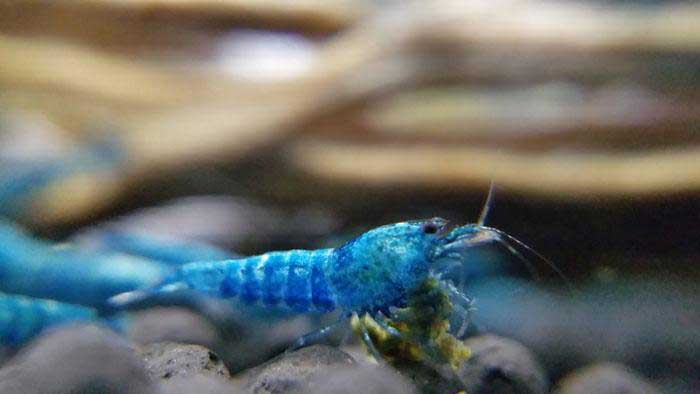
The blue bold is a stunning dwarf shrimp that has an extensive color that ranges from an extreme blue to hardly any blue.
The blue bolt is unique because it’s deep blue color is not permanent. It depends on genetics as well as the current aquarium water parameters.
Even though the blue bolts cost a pretty penny, they are not picky eaters. They will eat just about anything they find. They spend loads of time picking up algae and to supplement you can feed them once a day.
This is not the easiest type to keep or breed. But with the right information and proper practices, you should have plenty of success. It’s best to keep them away from fish if you intend to breed and keep an invert only tank.
Crystal Red Shrimp
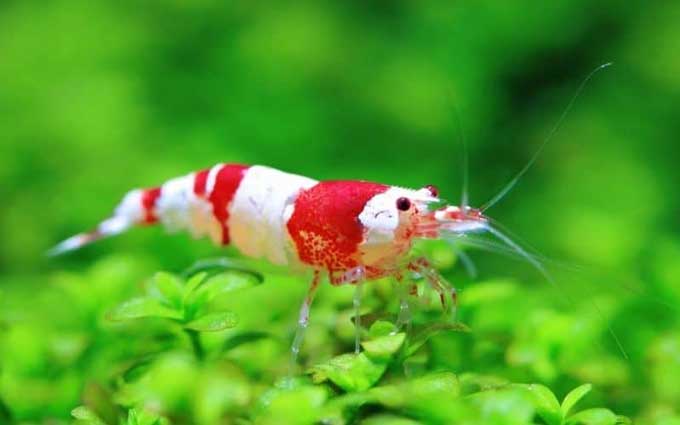
Crystal red shrimps complement your set up with bold shouting colors. Compared to the normal cherry shrimp, this variety is harder to keep and requires a bit of experience.
The CRS are peaceful and easily cohabit with other tank mates. You can pair them up with passive fish varieties that don’t prey on them if you want a diverse set up.
Soft, slightly acidic water works best for these beauties but they are known to adapt to a variety of conditions.
Bumble Bee Shrimp
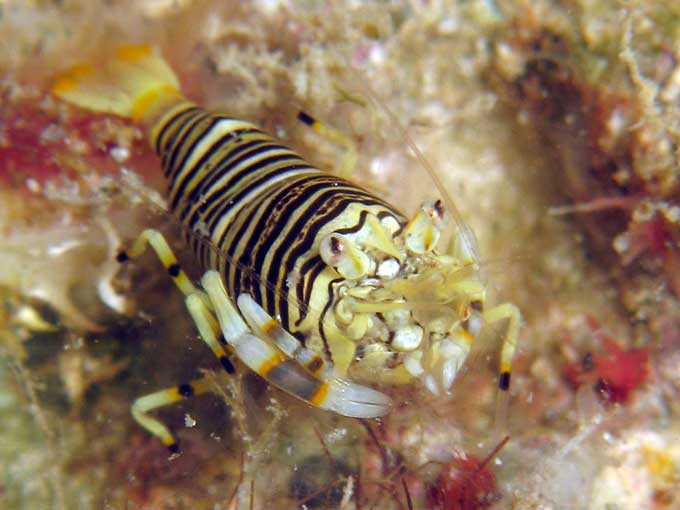
The bumble bee shrimp gets its name from its black and gold stripes. Also known as the striped harlequin shrimp, this indo-pacific native is exceptionally sensitive to water quality and grows to a maximum size of only one inch.
Because of their small stature, it’s best to keep the bumble bee shrimp in a shrimp only tank. It’s best to keep them in pairs and in a nano tank for easier viewing.
This little jewels feed on tube feet of echinoderms but you can supplement with frozen meaty foods. Feeding should be done daily.
Amano Shrimp
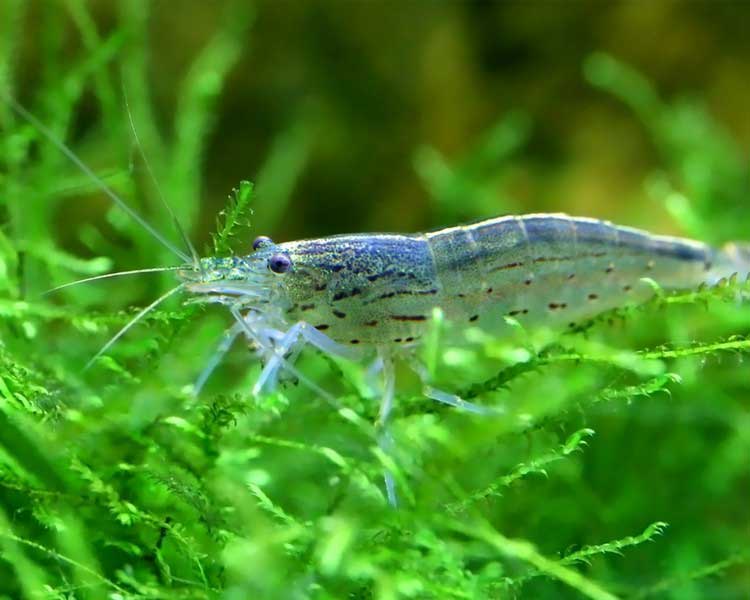
Amano Shrimp trace their origin to Taiwan and Japan. They are also called Yamato Shrimp or Japanese Shrimp. The Amano can live up to 2 years and grow up to 2 inches long. They are omnivores that love feeding on algae and love a heavily planted tank.
You can keep the Amano shrimp alone in an invert tank with other shrimps and snails. They are easy to care for but incredibly hard to breed. Like most shrimp varieties, they are commonly viewed as food which is why you should practice caution when introducing them into the tank.
Freshwater Aquarium Shrimp Tank Mates
Most shrimp and baby shrimp make a quick meal to most fish. If you’re planning to breed the shrimp, choosing the right tank mates that will not devour the clutch once hatched.
That said, choosing the right tank mates is vital to the survival of your shrimp. If you don’t want to keep a shrimp only tank, there are several options available for you.
Fish
If you must have fish co-existing with your shrimp, go for varieties that have sucker mouths like small plecos and otto cats. These will boost the clean-up crew and keep water quality high and most importantly leave the shrimp alone.
If you don’t plan on breeding, there are more options you can look at like tetras and guppies. Both are small and won’t prey on the adult shrimp.
Snails
In general, fresh water snails like ivory, Gold Inca, and Nerite make great tank mates for your shrimp. Some like the Spixi, Trumpets and Red Ramshorns bring additional benefits to the tank because they don’t eat the live plants.
Snails are good tank mates even when you’re breeding because they don’t eat the babies, help in tank clean up and some of the varieties have stunning bright colors which complement the shrimp.
There are additional benefits to having snails co-exist with shrimp. Other than taking care of uneaten foods, Trumpet snails burrow into the substrate which helps to oxygenate the substrate which supports bacterial colonies that help your tank thrive.
Some types of snails like the Spixi don’t thrive in small set ups. It’s important to carefully weigh your options before you decide on which type of snail you would like to keep with your shrimp.
How to Care for Your Freshwater Aquarium Shrimp
Shrimp are more sensitive to water quality changes than fish. Like fish, the ideal environment and tank parameters vary depending on the type of shrimp you want to keep.
Tank and Water Requirements
- On average, most shrimp require at least 10 gallons of water. Smaller varieties can thrive on less than 10 gallons.
- The filter should have sponge wrap over the intake and have low suction so the shrimp is not sucked into the system. Alternatively, you can use an air driven sponge filter which is safer for the shrimp.
- Monitor levels of ammonia and nitrates. These should be kept at undetectable levels. However, the requirements depending on the type of shrimp.
- Make sure the pH level of your tank is favorable to the type of shrimp. Some prefer acidic, while others thrive in slightly acidic environments.
- To ensure you have the right setup for your shrimp, conduct comprehensive research to make sure you provide the shrimp with the perfect environment for them to thrive.
- Partial water changes should be conducted every week. Change about 10% of the water the first week then 25% the second week, and repeat.
Feeding
Freshwater shrimp feed on algae. You should make sure the tank you choose is cycled several times. In a healthy community, the algae and biofilm that forms on the aquarium is enough to sustain the colony.
For larger populations, you can supplement using a variety of foods which include;
- Flakes
- Blanched vegetables like spinach, cucumbers or pears.
- Shrimp pellets
- Bottom feeder tablets
- Tropical color flakes
- Tropical granules.
Shrimp are not picky eaters so feeding them shouldn’t be a problem. Doing some due diligence to find out what types of foods your type of shrimp prefers can make the feeding process much easier.
If you’re not sure how much food to give, less is better. Uneaten food inside the tank can cause ammonia and nitrate levels to rise killing all your shrimp.
Place a small amount of food at the top of the tank and observe how fast the shrimp eat. After an hour, remove all the uneaten food.
You should only feed your shrimp once a day. But, the feeding requirements also depends on the population and type of shrimp. You can experiment with different amounts before settling on an ideal amount and feeding schedule.
Final Thoughts
There are plenty of colorful and amazing freshwater shrimp options. Going for the most colorful and attractive sounds like a plan, but as you might have learned, doing a little research can save you from tons of trouble and improve your chances.
Most importantly, make sure you understand the type of shrimp you would like to keep and that it complements your skill level. If you intend to breed, go for varieties that are easy and quick to breed and make sure you know all predators and keep them away from the tank.
By following this quick and simple guide, you have everything you need to setup your first freshwater shrimp tank.
